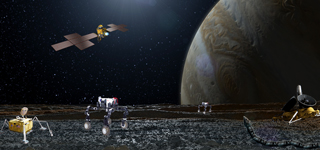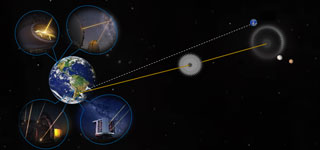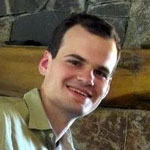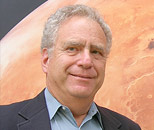Engineering


Programs

One-shot Outer Solar System Exploration with Software-defined Space Systems
This KISS Study Program will aim to 1) establish the concept of software-defined space systems (SDSSs) that can adapt their functions at all levels, from science instruments to robotic capabilities, after launch through software updates, and 2) formulate a concrete and well-defined one-shot multifaceted mission.

Hybrid Space-Ground Observatories: Revolutionizing the Search for Earth-like Exoplanets
This KISS study program will study hybrid ground-space observatories by integrating ground-based telescopes equipped with adaptive optics, and optical components placed in suborbital or orbital locations.

Interplanetary Laser Trilateration Network
The goal of this study program is to develop plans for a future planetary geodesy measurement protocol that would improve the state of the art for planetary ranging by up to three orders of magnitude, using a triad of spacecraft with laser communications deployed in orbit around Venus, Earth, and Mars.

Metasurface Optics for High-Contrast Imaging: Design, Fabrication, and Implementation
The workshop on "Metasurfaces for Exoplanet Detection and High-Contrast Imaging" aims to convene a diverse group of researchers, including end-users, designers, fabricators, and metrology experts, to explore and advance the application of metasurface optics in the field of astronomy and high-resolution imaging.

Enabling Fast Response Missions to NEOs, ISOs, and LPCs
This study will leverage previous results from that 2018 KISS study, especially in the realm of science traceability, instrumentation, and concept of operations. This study will dive directly into the mission lifecycle changes required to explore an ISO and LPC and will dive deeper into “rapid response”, develop strategies and identify technologies to enable the up-close exploration of the next ISO or LPC discovered.

Targeting Microhabitats for Life Detection
This KISS study will examine and advance 1) non-destructive instrumentation to detect biosignatures (agnostic and Earth inspired); 2) sampling techniques to collect and preserve microhabitats while retaining the spatial context; and 3) culturing of acquired microorganisms.

Venus In-Situ Sample Capture Mission
The goal of the study is to develop new concepts for in situ sample capture missions, where samples from the Venusian surface or lower atmosphere are delivered to an “airborne laboratory” for analysis. Study participants will identify approaches to in situ sample retrieval and analysis, analyze the feasibility of the approaches, and determine the technology needed and pathways to development.

Non-Nuclear Exploration of The Solar System
This study will investigate a system architecture with the potential to provide solar-powered transportation to the outer planets and solar power in orbit at the destination.

Beyond Interstellar: Extracting Science from Black Hole Images
A goal of the KISS study is to explore fundamental questions in black hole physics, to review the science motivation for event horizon scale probes, to assess and explore techniques to connect observations to the underlying black hole physics, and to evaluate what ancillary science might be possible with future space-enhancements to Earth-based arrays like the EHT.

Nebulae: Deep-Space Computing Clouds
The goals of this study program are to identify new science missions enabled by a nebula; to quantify benefit to traditional, existing, and planned science missions; to identify candidate mission architectures and demonstration milestones for follow on proposal development for all participants.

Data-Driven Approaches to Searches for the Technosignatures of Advanced Civilizations
The focus of the study is new approaches toward the search for intelligent life elsewhere in the Universe. We will explore the possible paths for a systematic exploration of observable parameter spaces derived from the modern sky surveys, using machine learning and other computational tools.

Large Constellations and Formations for Exploring Interstellar Objects and Long-Period Comets
This KISS study will investigate the best strategies for exploring planetary objects with very long periods such as ‘Oumuamua, the first interstellar visitor ever observed, and comets coming from the Oort cloud.

Accessing the Subsurface Oceans of Icy Worlds
This KISS study is devoted to the question of accessing the subsurface oceans of icy worlds in order to explore these water oceans and to discover the presence of alien extant life. The goal is to review the different technologies that have been developed and to define the technologies that are still required.

Space Science Opportunities Augmented by Exploration Telepresence
The aim of this workshop will be a critical review of a potentially new space exploration strategic approach: field scientific research on planetary surfaces conducted by astronaut/scientists using robotic surrogates when the distance from the scientists to the robots is so short as to provide the illusion of being part of the surface environment without requiring humans to be physically at the site.

Optical Communication on SmallSats – Enabling the Next Era in Space Science
This study will bring together space scientists, technologists, and mission designers across two workshops to understand the current limitations faced by SmallSat science missions stemming from the communication bottleneck, and together craft novel technical approaches for optical data transfer that significantly enhances the quality and volume of data returned by these missions.

Addressing the Mars ISRU Challenge: Production of Oxygen and Fuel from CO2 using Sunlight
This Keck Institute Space Science study will examine the photoelectrochemical production of fuel (such as carbon monoxide) and oxygen from carbon dioxide on the Mars surface. The main technical goals will be to identify specific photoelectrochemical pathways that are well suited for carbon dioxide reduction in the unique Mars environment, as well as viable designs for scalable Mars oxygen and fuel production devices.

Optical Frequency Combs for Space Applications
The goal of this program is to formulate space applications and mission concepts enabled by optical frequency comb technology and to identify high priority technology challenges and gaps that need to be addressed to implement these missions.

Three Dimensional (3D) Additive Construction for Space using In-Situ Resources
This study will consider how three-dimensional (3D) additive construction using in-situ resources can vastly decrease the launch mass required to establish exploration infrastructure on other planetary surfaces.

Adaptive Multi-Functional Space Structures for Micro-Climate Control
This study will bring mission designers together with experts in these technologies, resulting in a better understanding of where we can best apply these ideas in space science, and leading toward development of the most promising concepts.

Airships: A New Horizon for Science
The aim of this study is to inform scientists of the capabilities of airship vehicles as instrumental platforms.

Satellites to the Seafloor: Autonomous Science to Form a Breakthrough in Quantifying the Global Ocean Carbon Budget
The principal goal of this study is to determine whether emerging technologies could enable crucial oceanographic and space science investigations.

In Situ Science and Instrumentation for Primitive Bodies
The goal of this study is to develop new methods to test the radically new understanding of solar system formation that has recently emerged, and to identify innovative instrumentation targeted to this purpose.

Quantum Communication, Sensing and Measurement in Space
The technical objectives of this program is to identify the set of application areas in space communications and sensing that could benefit from novel quantum-enhanced techniques.

Engineering Resilient Space Systems
The goal of this study program is to investigate the system capabilities, software architectures and autonomy technologies that will provide the needed resilience for future missions.

Small Satellites: A Revolution in Space Science
The main objective of this study is to identify the technology challenges that must be overcome to advance SmallSat capabilities for revolutionary space science observations.

Asteroid Return Mission Study
The aim of this program is to investigate the feasibility of finding, characterizing, robotically capturing, and returning an entire Near Earth Asteroid (NEA) to the vicinity of the Earth.

Digging Deeper: Algorithms for Computationally-Limited Searches in Astronomy
Our technical goal of this program is to develop a few realistic, benchmark problems on which the methods can be compared, keeping in mind computational resources and available architectures.

Next Generation UV Instrument Technologies Enabling Missions in Astrophysics, Cosmology and Planetary Sciences
The goal of this study is to create a new paradigm in UV/Optical instrument design, detector technology, and optics to form the foundation for the next generation of UV/Optical missions.

xTerramechanics - Integrated Simulation of Planetary Surface Missions
The goal of the program is to bring together key technical experts from across the U.S. to advance the study of surface interactions and to deepen our understanding of key mission life-cycle processes. The results will be enabling for many future missions in our solar system.

Future Missions to Titan: Scientific and Engineering Challenges
The goal of this program is to formulate revolutionary technology breakthroughs that will enable the development of sample acquisition systems and relevant instruments capable of in-situ operation during NASA's missions to extremely cold environments.

Monitoring Earth Surface Changes from Space
The aim of this program is to to discuss perspectives regarding the use or improvement of remote sensing techniques to image and measure seismic waves from optical and SAR systems.

Single Photon Counting Detectors
This study will significantly advance the capability to build single photon counting array detectors at submillimeter to ultraviolet wavelengths for astronomy, including optical single photon detectors for communications.

Large Space Structures
The aim of this study is to analyze the state of the art in optical and RF apertures and to make a lasting impact on the field of large space apertures.

Mission Concepts for Accessing and Sampling High-Risk Terrains on Planetary Surfaces
The goal of this workshop is to explore new potential mission concepts for the exploration of high-risk planetary surfaces.
Lectures
How a Team of Young Caltech/JPL Researchers Transformed the Field of Earth Observation with Spaceborne Radars
November 2, 2021
Speaker: Dr. Charles Elachi -
Professor of Electrical Engineering and Planetary Science (Emeritus, Caltech);
JPL Director (2001-2016)

SWARM: A New Paradigm for Communication Satellites
March 17, 2021
Speaker: Dr. Sara Spangelo - Swarm Technologies Co-founder and CEO

Mars 2020 Lecture: The Thrill and Terror of Landing a Spacecraft on Mars
February 17, 2021
Speaker: Rob Manning - Chief Engineer, JPL

Robotic Exploration of Titan with Dragonfly - An Overview of the Lander Mobility System
September 2, 2020
Speaker: Douglas Adams - The Johns Hopkins Applied Physics Laboratory (APL)

Origami and Spacecraft Structures: Current Work and a Brief History
February 12, 2020
Speaker: Dr. Manan Arya - JPL

Exobiology Extant Life Surveyor (EELS) Robotic Architecture
July 15, 2019
Speakers: Kalind Carpenter and Morgan Cable, JPL

Stimulating a Culture of Innovation at The Aerospace Corporation
April 17, 2019
Speaker: Rob Sherwood - Deputy Executive Director of Innovation at The Aerospace Corporation

PUFFER: NASA's Pop-Up Origami Rover
February 20, 2019
Speakers: Jean-Pierre de la Croix and Jaakko Karras, JPL

The Space Barons and the New Space Age
October 10, 2018
Speaker: Christian Davenport - The Washington Post

Automaton Rover for Extreme Environments: Steampunk Meets Spacecraft
November 6, 2017
Speakers: Dr. Jonathan Sauder and Evan Hilgemann - JPL

Artificial Intelligence Support of Rosetta Orbiter Science Operations
November 2, 2016
Speaker: Dr. Steve Chien - Senior Research Scientist, JPL

Operational Thoughts on Data Driven Decision Making
October 5, 2016
Speaker: Tyler N. "Nick" Hague - NASA Johnson Space Center

Building the First Spaceport in Low Earth Orbit
January 13, 2016
Speakers: John Blincow - Gateway Foundation
Tom Spilker - Retired (JPL)

Light, Atomic Clocks, and Testing Einstein’s Assumptions
November 4, 2015
Speaker: Dr. John L. Hall - JILA, University of Colorado and NIST - Nobel Laureate in Physics, 2005

Tyranny of the Rocket Equation
August 27, 2015
Speaker: Dr. Don Pettit - NASA Astronaut, Johnson Space Center

Mars Helicopter Scout
April 1, 2015
MiMi Aung,
Autonomous Systems Deputy Division Manager, JPL

The Future of Human Spaceflight
April 8, 2014
Moderator: Louis Friedman - Executive Director, Emeritus, The Planetary Society

CubeSat: An Unlikely Success Story
October 30, 2012
Jordi Puig-Suari,
Professor, Cal Poly, San Luis Obispo

Quantum Experiments in Space - From Quantum Technology to Quantum Foundations
June 27, 2012
Markus Aspelmeyer,
Professor of Physics, University of Vienna

Photons to Bits and Beyond: The Science and Technology of Digital Image Sensors
November 11, 2011
Professor Eric Fossum, Dartmouth College

Landing on Mars (do not try this at home)
April 11, 2012
Rob Manning
Chief Engineer, Mars Science Laboratory, JPL





